Article
Wheat Farms, Flour Mills, and Railroads: A Web of Interdependence (Teaching with Historic Places)
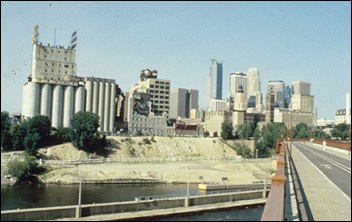
This lesson is part of the National Park Service’s Teaching with Historic Places (TwHP) program.
Describing Minneapolis's St. Anthony Falls in 1805, Zebulon Pike wrote that "the great quantity of water . . . forms a spray which in clear weather reflects . . . the colors of the rainbow, and when the sky is overcast covers the falls in gloom and chaotic majesty."¹ By 1860 much of this beauty had been destroyed, as mills on both sides of the river used the power of the falls to turn millions of bushels of wheat into flour.
Much of the wheat needed to feed these mills came from "bonanza" farms hundred of miles to the west on the endless plains of the Red River Valley. Ranging from 3,000 to 30,000 acres, these huge farms needed fleets of harvesters and armies of workers to gather their crops.
Steel rails linked the farms and the mills. The railroads provided the efficient, relatively cheap transportation that made both farming and milling profitable. They also carried the foodstuffs and other products that the men and women living on the single-crop bonanza farms needed to live.
The mills, the farms, and the railroads depended on each other for success; none could function and prosper in isolation. This efficient combination of farms, mills, and railroads dominated flour production in the United States for more than half a century.
¹Lucile M. Kane, The Falls of St. Anthony: The Waterfall That Built Minneapolis (St. Paul, MN: Minnesota Historical Society, 1966), 5.
About This Lesson
This lesson is based on the National Register of Historic Places registration files, "St. Anthony Falls Historic District," "Bonanza Farming in North Dakota," "Bagg Bonanza Farm District" (with photographs), and "St. Paul, Minneapolis and Manitoba Railway Company Shops Historic District"; The Falls of St. Anthony: The Waterfall That Built Minneapolis, by Lucile M. Kane; Checkered Years, by Mary Dodge Woodward; and documents supplied by the Minnesota and North Dakota historical societies. It was written by Rita G. Koman, an educational consultant. The lesson was edited by Fay Metcalf, Marilyn Harper, and the Teaching with Historic Places staff. TwHP is sponsored, in part, by the Cultural Resources Training Initiative and Parks as Classrooms programs of the National Park Service. This lesson is one in a series that brings the important stories of historic places into classrooms across the country.
Where it fits into the curriculum
Topics: This lesson could be used in American history, social studies, and geography courses in units on the rise of big business, mechanized farming, and railroads in the post-Civil War period or on the westward expansion of the United States. It could also be used in courses on economic history.
Time period: Late 19th to early 20th centuries
Objectives for students
1) To explain the interdependence of wheat production, flour processing, and transportation by analyzing the components involved.
2) To describe life and work on bonanza farms.
3) To seek evidence of industrial interdependence in their own communities and to identify local historic properties reflecting those developments.
Materials for students
The materials listed below either can be used directly on the computer or can be printed out, photocopied, and distributed to students. The maps and images appear twice: in a smaller, low-resolution version with associated questions and alone in a larger version.
1) one map showing Minnesota and North Dakota and the railroad systems that linked them together;
2) three readings about flour milling, wheat farming, and railroads;
3) five photos of the flour milling districts in Minneapolis, wheat harvesting, and a bonanza farm in North Dakota;
4) one drawing of a bonanza farm.
Visiting the site
Self-guiding tour brochures and other information about the St. Anthony Falls Historic District are available from the St. Anthony Falls Visitor Center, 125 Southeast Main Street, Minneapolis, MN 55414. The Minneapolis Heritage Preservation Commission offers guided tours of the historic district during the summer months; for tour schedule, fees, and reservations, contact the Commission, at the following address: Minneapolis Heritage Preservation Commission, City Hall, Room 220, 350 South Fifth Street, Minneapolis MN 55415-1385.
St. Anthony Falls is part of the Mississippi National River and Recreation Area, which interprets the story of the falls in a broad context. For more information, contact the Mississippi National River and Recreation Area, 111 E. Kellogg Boulevard, St. Paul, MN 55101-1256.
The Minnesota Historical Society offers tours of the James J. Hill mansion in St. Paul. For more information, contact the Minnesota Historical Society, 345 Kellogg Boulevard West, St. Paul, MN 55102-1906.
The only bonanza farmstead open to visitors is the Bagg Bonanza Historical Farm located south of Fargo, North Dakota, west of the junction of Interstate 29 and Highway 13. It is open Friday, Saturday, and Sunday from Memorial Day through Labor Day. For more information, contact the Bagg Bonanza Farm, P.O. Box 702, Mooreton, ND 58061.
Getting Started
Inquiry Question
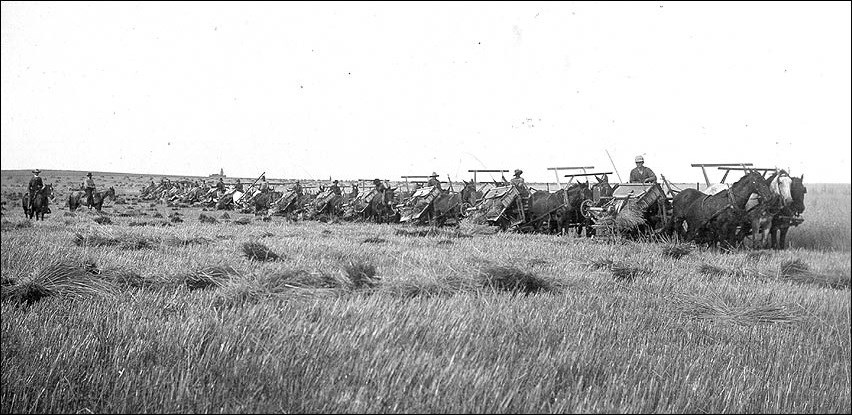
Setting the Stage
While the beauty of St. Anthony Falls attracted explorers and tourists as early as the 1700s, it was the fur trade that initially brought European-American settlers to this remote area and it was the power of the falls that made them stay in the area that would become Minneapolis, Minnesota. They knew they could use the weight of the falling water to turn waterwheels that, in turn, used a variety of shafts, belts, and pulleys to operate saws initially for timber milling until flour milling gradually took over. The Falls came under U.S. control with the Pike Treaty of 1805 when the Sioux Nation granted the United States, for the purpose of the establishment of military posts, nine miles square at the mouth of the river St. Croix, also from below the confluence of the Mississippi and St. Peters, up the Mississippi, to include the falls of St. Anthony, extending nine miles on each side of the river. In 1819, the U.S. Army 5th Regiment of Infantry arrived at the junction of the Mississippi and Minnesota Rivers to build the northwest link in this chain of forts and agencies. Here, where traffic could be controlled on two major rivers, Fort Snelling was completed in 1825 on the west side of the Mississippi River. In 1838 the east side of the river was opened for European-American settlement. Franklin Steele, a storekeeper from Fort Snelling, was first on the scene. Staking out his claim for about one-half mile of east-side shore land, Steele soon controlled half the waterpower at St. Anthony Falls.
In 1849 Robert Smith, a Congressman from Illinois, acquired a mill site on the west side of the Mississippi. In 1851 the west side was opened to settlement by European-American immigrants, but settlers were not granted title to the land until 1855. In 1856-58, Steele, Smith and numerous partners joined forces to build the main channel dam. Independent corporations developed the waterpower of their respective riverbanks making the power of the falls available to factories lining the canals. The first canal was built on the west side by the Minneapolis Mill Company. Flour mills soon became the dominant business. By the 1880s, 27 mills produced more than two million barrels of flour annually, making Minneapolis the nation's largest flour manufacturing center.
At the same time, 3,000-30,000-acre "bonanza" wheat farms were appearing on the flat, fertile prairies of the Red River Valley. Like the mills, these farms, with their large work forces, modern farming equipment, and single crop, were efficient industrial enterprises.
Growing large crops of wheat could only be profitable if there were high-production flour mills willing to buy it and a relatively low-cost method of getting it there. Nor was there any profit to be made in building a large flour mill without both sufficient quantities of wheat and a way to get it to the mill. The railroads provided the link that made both farmers and millers successful. They carried raw materials to the mills, finished products to the farmers, and flour to consumers all across the nation.
Locating the Site
Map 1: Railroads in Minnesota and North and South Dakota, 1890.
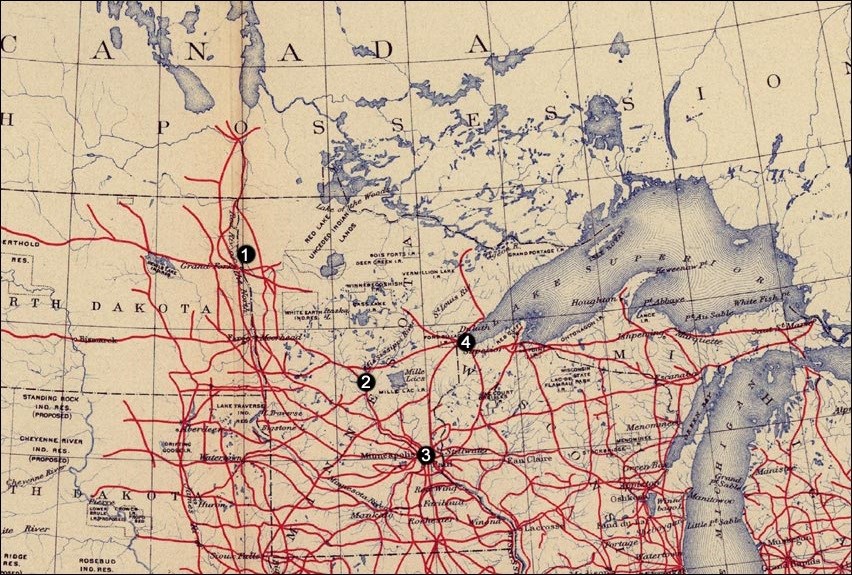
(Library of Congress)
Map Key:
1. Red River of the North
2. Mississippi River
3. Minneapolis, MN
4. Duluth, MN
Questions for Map 1
1. Locate the Red River of the North (the border between Minnesota and North Dakota); the Mississippi River; Minneapolis, Minnesota; and the Great Lakes port of Duluth, Minnesota.
2. The broad valley of the Red River was not settled until the 1870s. It was flat, fertile, treeless, and with more rainfall than areas further west, well adapted to large-scale wheat farming. Why might these conditions be condusive to farming?
3. Why do you think there were so many railroad lines in the Red River Valley by 1890? What impact do you think this would have had on farming and flour milling? If needed, refer to Setting the Stage.
Determining the Facts
Reading 1: Flour Milling
Flour mills began to be established in the town of Minneapolis in the mid-1850s. Powered by St. Anthony Falls, the mills were supplied with rapidly increasing crops of wheat grown by new settlers in western and southern Minnesota and the Dakotas. Railroads began linking Minneapolis to the west in the late 1860s. The number of Minneapolis flour mills grew rapidly.
A few things kept the Minneapolis mills from competing successfully with flour mills in other parts of the country, however. When flour was made from the hard spring wheat of the Northern Plains using conventional milling techniques, it was discolored and speckled with particles of husk or bran, and it did not keep well. In addition, conventional mill stones destroyed much of the most nutritious part of the wheat kernel.
In the 1860s and 1870s, the millers solved these problems. They developed a process that made it possible to separate the nourishing "middlings" layer of the wheat kernel, process it, and return it to the flour. A second innovation replaced conventional millstones with large chilled porcelain or iron rollers that ran at a lower speed. This prevented discoloration due to heat and minimized the crushed husk and bran that speckled the flour. By the late 1870s Minneapolis flour was recognized as the best in the nation, and it quickly replaced winter-wheat flour in both national and international markets. The mills located on the west bank of the Mississippi made that area the nation's leading flour center.
The Pillsbury Company completed its gigantic A Mill on the east side of the river in 1880. Containing two identical units, it had a capacity of 4000 barrels of flour a day when it opened. By 1905 the mill had tripled its output. Its owners claimed that it was the largest flour mill in the world. Over the years numerous buildings were added to the complex, including a grain storage elevator built in 1910 and linked to the mill by conveyors, another elevator and annex built between 1914 and 1916, and a cleaning house and nine-story warehouse built in 1917. The Pillsbury A Mill is the only mill still operating in the St. Anthony Falls milling district.
Tremendous consolidation took place within the flour industry between 1880 and 1900, as numerous mergers occurred. In 1876, 17 firms operated 20 mills; in 1890, four large corporations produced almost all of the flour made in Minnesota. By the early 1900s, three corporations based in Minneapolis controlled 97 percent of the nation's flour production. They were Washburn-Crosby Company, which became General Mills; Pillsbury-Washburn Flour Mills Company, which became Pillsbury Flour Mills Company; and Northwestern Consolidated Milling Company, which became the Standard Milling Company. This Minneapolis "Flour Trust" dominated the national flour market until the 1930s.
As consolidation took place, the number of operating mills stabilized at about two dozen, but auxiliary buildings multiplied rapidly. Warehouses, grain elevators, boiler rooms, engine houses, packing facilities, and railroad tracks crowded the land along the river. Over the years, the labor of many men constructed canals, mills, and support buildings. Others unloaded newly arrived grain onto conveyor belts that carried it to the millers, who put it through the rollers and processed it into the final product. Still other workers packed the flour, first into barrels and later into bags. Under brand names like Gold Medal and Pillsbury's Best, the newly packaged flour found its way to markets all over the world.
Questions for Reading 1
1. What initially kept the Minneapolis mills from competing sucessfully? How did the millers solve this problem?
2. How did the Pillsbury A Mill set the standard for the flour milling industry?
3. Why do you think Minneapolis came to dominate flour milling in the United States?
4. What three companies ended up with a near monopoly of the American flour industry? Have you ever seen or used any of their brands of flour?
Determining the Facts
Reading 2: The Bonanza Farms of North Dakota
Huge farms in the valley of the Red River of the North provided much of the wheat needed for the new flour mills in Minneapolis. Wheat farming in that region was stimulated by a serious financial problem affecting the Northern Pacific Railroad, which ran from St. Paul and Minneapolis, Minnesota, through Fargo, North Dakota, and then westward. Northern Pacific stock lost its value in the Panic of 1873. Stockholders agreed to exchange their worthless stock for some of the land the railroad had received from the Federal Government, but soon found that no one would buy the land in Dakota Territory, described on most maps as the "Great American Desert."
George W. Cass, president of the Northern Pacific, and George Cheney, a board member, needed to prove to potential buyers that the land was fertile and productive. They thought that "bonanza" farms, huge acreages growing only wheat, might make their point. The Northern Pacific investors hired wheat expert Oliver Dalrymple to develop and manage their demonstration farm. The Cass-Cheney farm (always called the Dalrymple farm by locals) was located about 20 miles west of Fargo. It grew from 5,000 acres in 1877 to 32,000 acres by 1885, and yielded as much as 600,000 bushels of wheat per year. This massive enterprise required 600 men at seed time and 800 at harvest, 200 plows, 200 self-binding reapers, 30 steam threshers, 400 teams of horses or mules, and several managers for each of the 2,500-acre tracts included in the property.
Other huge farms, ranging from 3,000 to over 30,000 acres, soon appeared in the Red River Valley. The soil, topography, and climate were ideal for large scale farming. An influx of Northern European immigrants brought good farmers who were not deterred by the cold winters. Off-season loggers from Minnesota's timber industry provided the seasonal manpower that the bonanza farms required.
Mary Dodge Woodward helped her son manage a farm near Fargo in the 1880s. Although the 1500-acre farm was too small to be officially classified as a bonanza farm, the diary she kept is the best description we have of what life was like on these farms:
(May 7, 1884) The grass begins to grow, and soon the whole prairie will look beautiful. . . .We have fifty acres for a dooryard. All the rest is sowed with grain and now looks like green velvet.
(September 19, 1884) The first frost. Looking from the granary steps with the telescope I could see twenty threshing machines running. The weather is perfect and they will thresh an average of 1,500 bushels each.
(April 11, 1885) I am glad that we can have the same men that were here last year. They planted eighty acres yesterday which was a big day's work, as seeding is the hardest part of farming in Dakota. The men walk between eighteen and twenty miles a day besides lifting sacks, filling seeders, and managing horses; moreover it is frequently either muddy or dusty in the spring.
(May 23, 1885) The wind blows all the time, so hard that one can scarcely stand before it. . . . About four o'clock the sky looked fearful, we heard a distant roar, and soon the storm was upon us. The hailstones were as large as nutmegs and oh, how they did kill things! . . . Our wheat that looked so green has disappeared and the fields are bare.
(August 11, 1885) Harvest has started. Now there will be no rest for man, woman, or beast until frost which comes, thank heaven, early here. I was nearly beside myself getting dinner for thirteen men besides carpenters and tinners. . . . I baked seventeen loaves of bread today, making seventy-four loaves since last Sunday, not to mention twenty-one pies, and puddings, cakes, and doughnuts.
The men cut one hundred acres today. All four of our harvesters are being used as well as three which were hired to cut by the acre. Things look like business with seven self-binders at work on this home section. The twine to bind our grain will cost three hundred dollars this year.
(October 2, 1885) The house is filled with smoke this morning. The air is heavy and it is three weeks since we had rain. The burning straw and prairie fires together fill the whole country with smoke. . . . If the fire should get inside, we would all burn out. Nothing could save us. The fire ran along the Northern Pacific tracks last night so the train did not dare pass the slough bridge. . . . At times the smoke is perfectly suffocating.
(August 6, 1886) A beautiful day. The men are all harvesting. Not even a chore man is left on the place. They have been cutting sixty acres a day with all five harvesters running. . . . Some of the men are shocking [stacking sheaves of grain upright in a field for drying]. . . . The reapers are flying all about us, stretching out their long white arms and grasping the grain. They remind me of sea gulls as they glisten in the sunshine.
(August 13, 1887) Our family has increased until there are thirty-two. We have put the cook stove in the blacksmith shop. The men have taken all the machinery from the machine house and put in tables with bunks overhead, making a fine new living quarter. We have a man cook and he has taken sixteen at his table out there.
The yard is full of threshers. They have been running the new machine to try it. . . . It looks very queer indeed to see an engine running around the yard with no horses attached to it. They whistle and toot and frighten the chickens and some of the horses. At present there is about a mile square covered with buildings and machinery.¹
By the early 20th century, the day of the bonanza farm had passed. Run as a large-scale business, the farms operated on a very narrow profit margin. The price of land began to rise after 1900, as did corporate taxes. Costs of labor and equipment rose as wheat prices fell. The huge farms were gradually broken up, but the geography of the valley dictated that the new farms still would encompass thousands of acres.
The bonanza farms had been a useful experiment. They demonstrated the fertility of the Red River Valley and brought in many settlers. The investors in the Northern Pacific Railroad made good their losses. The railroads profited from their share of wheat-hauling, as well as from the shipments of goods purchased by the wheat farmers. As a model and an ideal, the bonanza farms helped transform agriculture from a family-based, animal-powered effort in the 19th century to a technologically-oriented business in the 20th century.
Questions for Reading 2
1. Look up the word "bonanza" in the dictionary. Most bonanzas on the American frontier were in mining or ranching. What do you think the word might mean applied to a farm?
2. Why do you think it took so long for farmers to settle here?
3. Why did the Northern Pacific Railroad want to encourage large wheat-growing businesses?
4. What conditions in the Red River Valley favored large-scale wheat cultivation?
5. Go over the excerpts from Mrs. Woodward's diary and make a list of kinds of work, types of machines, effects of weather, things she liked, and things she didn't like. What threats to the wheat crop can you identify? Do you think such a business was a practical venture? What other generalizations can you draw? Would you have liked to live and work on a bonanza farm?
6. How do you think the introduction of steam-powered machinery would have affected wheat farming generally, and bonanza farms in particular?
Reading 2 was compiled from Lauren McCroskey, "Bonanza Farming in North Dakota" National Register of Historic Places Multiple Property Submission, Washington, D.C.: U.S. Department of the Interior, National Park Service, 1990; Marty Perry, "Bagg Bonanza Farm District" (Richland County, North Dakota) National Register of Historic Places Registration Form, Washington, D.C.: U.S. Department of the Interior, National Park Service, 1985; Harold Briggs, "Early Farming in the Red River Valley of the North" (a paper presented at the joint session of the Agricultural History Society with the American Historical Association, Minneapolis, December 28, 1931), 27-28; and Merrie Sue Holtan, "The Bonanza Farms," North Dakota Rural Electric Cooperative Magazine (January 1989), 42-44; and Mary Dodge Woodward, The Checkered Years, Mary Boynton Cowdrey, ed., Caldwell, ID: The Caxton Printers, Ltd., 1937, (reprint edition, St. Paul, MN: Minnesota Historical Society Press, 1989), 40-184, used by permission.
¹Mary Dodge Woodward, The Checkered Years, Mary Boynton Cowdrey, ed., Caldwell, ID: The Caxton Printers, Ltd., 1937, (reprint edition, St. Paul, MN: Minnesota Historical Society Press, 1989), 40-184, used by permission.
Determining the Facts
Reading 3: The St. Paul, Minneapolis, and Manitoba Railway
Although the bonanza farms of North Dakota were largely created by the Northern Pacific in the 1870s, the St. Paul, Minneapolis, and Manitoba Railway (StPM&M) had taken over the bulk of the wheat trade by the 1890s. The StPM&M operated almost a thousand miles of track in North Dakota, carefully planned to serve the needs of wheat growers in the Red River Valley. In 1894, the railroad, renamed the Great Northern in 1890, carried 20.7 million bushels of wheat. Only about 6 million bushels were shipped over the Northern Pacific.
The StPM&M was the creation of James J. Hill. Born in Ontario, Canada, in 1838, Hill immigrated to St. Paul, Minnesota, at the age of 17. St. Paul was the northern terminus of the riverboat trade on the Mississippi River. Hill quickly found work as an agent for a steamship. After 20 years working in the shipping business on the Mississippi and Red rivers, Hill and three other investors purchased the nearly bankrupt St. Paul and Pacific Railroad in 1878, renaming it the St. Paul, Minneapolis and Manitoba Railway Company the following year. As president of the new company, Hill soon began to "branch out generally" into Minnesota, Dakota, and Manitoba.¹ The generally north-south running routes of Hill's railroad soon dominated the trade of the Red River Valley. The StPM&M began calling itself the "Red River Valley Line."² Wheat accounted for 20 percent of the railroad's total freight in the early 1880s.
In the late 1880s, the Minneapolis millers were looking for better rail connections with the wheat growing areas in the west. In 1880, agreement was reached that Hill would build new facilities in Minneapolis, including a new passenger station, and share them with all the railroads serving the city. The new Minneapolis Union Railway, with Hill serving as president, built a new stone arch bridge across the Mississippi. The bridge led both to the new terminal and to the tracks serving the mills on the west side of the river.
In 1882, Hill also built a complex of fine new railroad shops in St. Paul, the headquarters of the St. Paul, Minneapolis, and Manitoba. At the shops technicians built and serviced locomotives, passenger cars, and freight cars. The shops also housed the purchasing department and served as the storehouse for the entire railroad. In the 1880s, one fourth of St. Paul's work force was employed in railroad-related jobs.
The Manitoba continued to expand its lines to serve the agricultural areas of the upper Mississippi and Red River valleys, but Hill began to be concerned about its heavy reliance on highly seasonal wheat shipments and about increasing competition from other railroads, including the Northern Pacific. In 1889, he resolved to extend his railroad to the Pacific. The Great Northern Railway, the last of the great transcontinental railroads and once known as "Hill's Folly," reached Puget Sound in 1892. Hill was well aware that the success of the new railroad still depended on the success of the farmers along its route. As he expanded into new territory, Hill became a leading advocate of diversified farming, far different from the single-crops of the bonanza farms.
Often called high-handed, tight-fisted, and cantankerous, James J. Hill continued to bring change to the railroad business. In order to reduce competition, he eventually acquired control of his old rival, the Northern Pacific. It took a landmark Supreme Court decision to dissolve the Northern Securities Corporation, a national railroad holding company that Hill helped create. Hill was so powerful that both the man and his railroad became known as the "Empire Builder." When he died in 1916, he left behind a great railroad system, depots, shops, yards, and the great stone arch bridge across the Mississippi River in Minneapolis as his monuments.
Questions for Reading 3
1. How did Hill get started in transportation?
2. How important was wheat shipping to the St. Paul, Minneapolis, and Manitoba? Why do you think Hill was concerned about his railroad's dependence on wheat shipments?
3. Why do you think Hill worked hard to reduce competition in the railroad business?
4. Explain, in your own words, how the flour mills, bonanza farms, and railroads depended on each other. Do you think most businesses function on this same web of interdependence today? Why or why not?
Reading 3 was compiled from John D. Mecum, "St. Paul, Minneapolis, & Manitoba Railway Company Shops Historic District" (Ramsey County, Minnesota) National Register of Historic Places Registration Form, Washington, D.C.: U.S. Department of the Interior, National Park Service, 1986; and from Ralph W. Hidy, Muriel E. Hidy, and Roy Scott, with Don L. Hofsommer, The Great Northern Railway: A History (Boston: Harvard Business School Press, 1988).
¹Minneapolis Tribune, Dec. 13, 1880; cited in Ralph W. Hidy, Muriel E. Hidy, and Roy Scott, with Don L. Hofsommer, The Great Northern Railway: A History (Boston: Harvard Business School Press, 1988), 40.
²Hidy, et al., Great Northern Railway, 45.
Visual Evidence
Photo 1: West Side Milling District, Minneapolis,
ca. 1890.
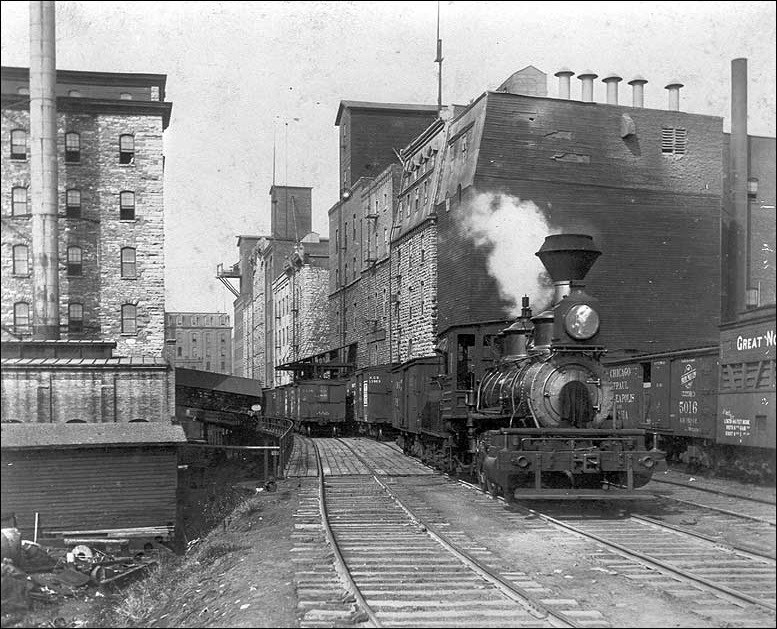
(Minnesota Historical Society, photographer unknown)
This view shows the flour mills lining the railroad on the west bank of the Mississippi River in Minneapolis. The tracks were built on a trestle over the canal that carried water from St. Anthony Falls to power the mills. Cars like the Great Northern box car partially cut off by the right edge of the photo carried wheat from the farms to the mills and flour from the mills to consumers.
Questions for Photo 1
1. How many railroad tracks can you identify in this photo. Why do you think so many were needed?
2. Why do you think it would have been useful to have the tracks so close to the mills?
Visual Evidence
Photo 2: West Side Milling District, Minneapolis, early 1920s.
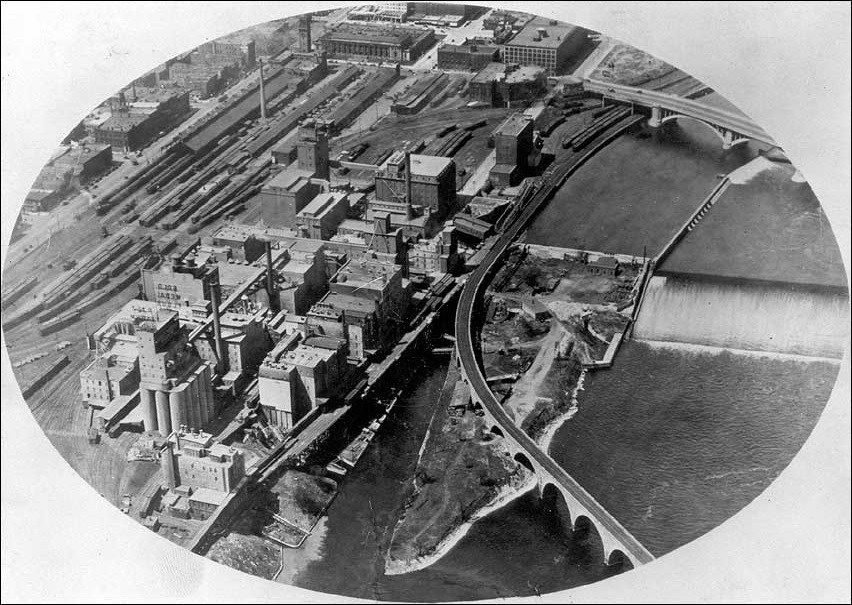
This photo shows an aerial view of the west side flour mills and grain elevators at the Falls of St. Anthony. The falls are shown at the right edge of the photo.
Questions for Photo 2
1. Examine the photo and try to identify the area shown in Photo 1. Can you find the railroad tracks shown in the first photo? Can you find other rail lines that appear to lead to the mills?
2. A wooden apron was placed over the falls in 1866. The apron was replaced many times and ultimately converted to cement in 1955 to prevent its erosion. This destroyed the picturesque beauty seen by early visitors. Look up the word "apron" and write down what it means in relation to a dam. Why do you think the millers wanted to a cement apron to protect the falls?
3. Locate James J. Hill's curving stone arch bridge in the center of the photo. It is believed to be the oldest mainline railroad bridge over the Mississippi River. Declared a National Civil Engineering Landmark by the Society of Civil Engineers, this bridge has not been used for rail traffic since 1978. It has recently been restored for pedestrian use. Do you think structures like this should be preserved? Why or why not?
4. What is your overall impression of the district? Do you think the industrial complex takes away from the falls? Why or why not?
Visual Evidence
Photo 3: Pillsbury Mill Complex.
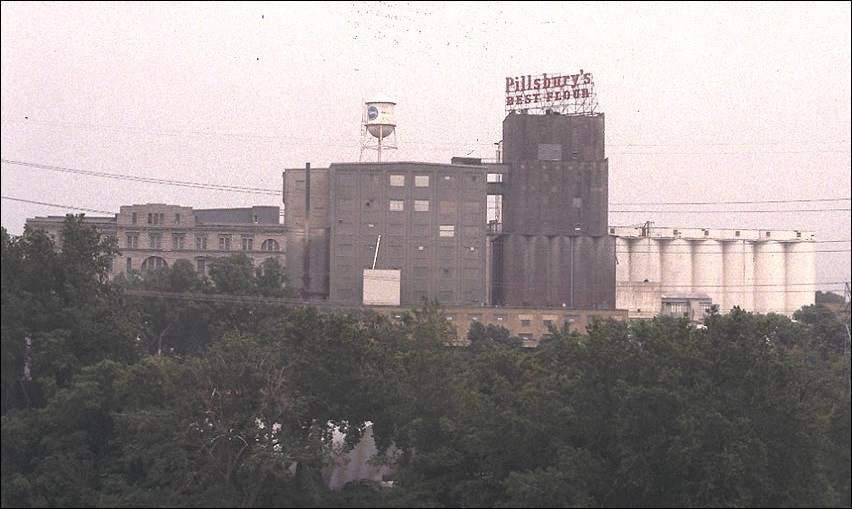
Photo 3 shows the Pillsbury complex. The Pillsbury A Mill on the left was built in 1881 at a cost of nearly half a million dollars. The large cylindrical buildings on the far right of the complex are reinforced concrete grain elevators. Each cylinder is a separate storage unit, holding thousands of bushels of wheat. Reinforced concrete provided cheap and efficient storage and some protection against the constant danger of explosions from spontaneous combustion of the wheat.
Concrete grain storage elevators were developed in Minneapolis by the Peavey Company. Their first elevator is still standing just west of Minneapolis.
Questions for Photo 3
1. What does the sign on top of the tallest building say? Why do you think Pillsbury would advertise on its mill buildings?
2. Count the grain elevators in this photo. What was the advantage of using reinforced concrete for storage? Note the size of the containers. Why do you think it was necessary to have such large structures for storing the wheat?
3. What claim did the owner make about the complex in the early 1900s? If needed, refer to Reading 1. Does this image help you understand the size and complexity of this complex? Why or why not?
Visual Evidence
Photo 4: Wheat Harvesting on a Bonanza Farm,
ca. 1891.

Questions for Photos 4
1. This photo shows binders used to tie harvested wheat into bundles. How many can you identify?
2. These machines were only used during the months of August and September. Some farmers owned their own equipment while others hired threshing crews that moved from farm to farm. What do you think would be the advantages and disadvantages of each method?
3. Bonanza farms grew nothing but wheat. What would be the advantages of doing this? What would be the disadvantages?
Visual Evidence
Photo 5: Bagg Bonanza Farm,
ca. 1930s.
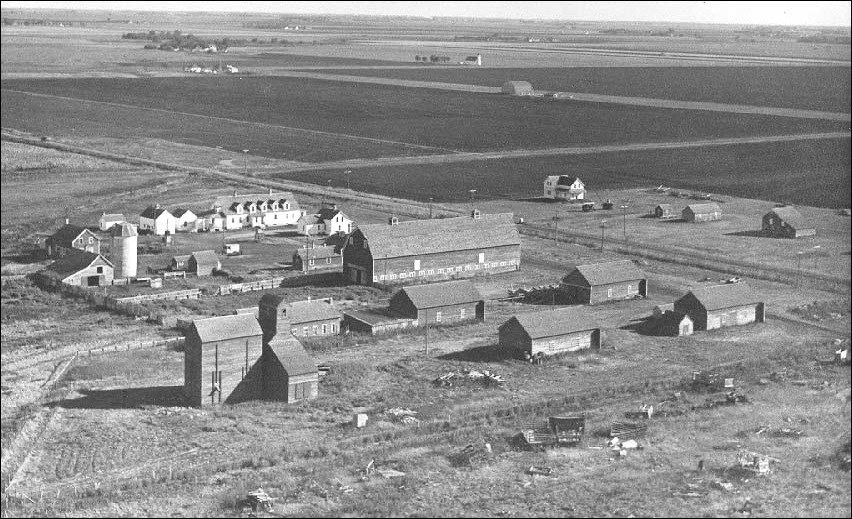
The Downing-Bagg bonanza farm originally consisted of 9,000 acres. When J. F. Downing died in 1916, his nephew inherited one-fourth of the land. He moved the buildings and machinery a mile away and began his own bonanza farm, which would eventually total 6,000 acres. Photo 5 is an aerial view of the headquarters of the Bagg farm.
Drawing 1: Bagg Bonanza Farm, 1985.
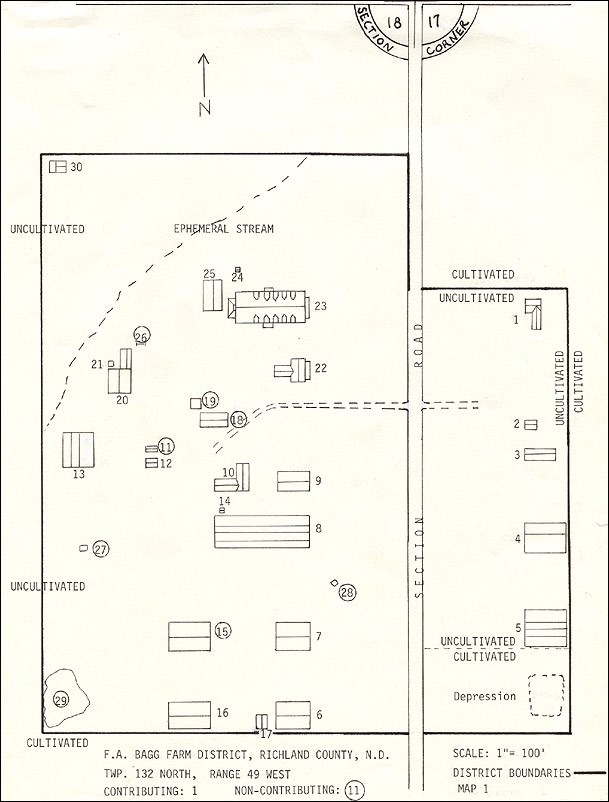
(National Park Service)
This plan shows the buildings and structures on the Bagg Bonanza Farm when it was nominated to the National Register of Historic Places. The circled numbers indicate buildings that are either modern or so changed that they cannot be considered historic.
Key to Map 2
1. Owners' residence (lived in by them only briefly)
2 and 3. Storage sheds
4. Granary
5. Sheep barn
6 and 7. Machine sheds
8. Long barn (blew down in a storm in the 1950s, ruins removed in 1999)
9. Harness workshop
10. Bunkhouse
11. Modern oil supply shed
12. Iron supply shop
13. Cow barn
14. Privy
15. Collapsed barn
16. Machine shed
17. Shed
18. Modern building
19. Modern shed
20. Blacksmith shop
21. Blacksmith shop privy
22. House used by relatives of the owner
23. Bunkhouse
24. Privy
25. Ice house
26. Modern hoist
27. Threshing machine
28. Modern combine
29. Miscellaneous vehicles and parts
30. Chicken coop
Questions for Photo 5 and Drawing 1
1. Note the large wooden elevator in the lower left of Photo 5. Farmers stored wheat in these elevators until they were shipped by rail. They sometimes waited several months before shipping their grain. Why do you think they might have done that?
2. Compare Photo 5 with Drawing 1. Label the structures on Photo 5 using the corresponding numbers from Drawing 1. How many buildings shown in the 1930s can you find on the 1985 map?
3. What characteristics of the landscape shown in Photos 4 and 5 might make it easy to farm this land. Can you find any that might indicate problems? If needed, refer to Reading 2.
4. Even after the bonanza farms were broken up in the early 20th century, farms in the Red River Valley tended to be very large. Why do you think that was the case? How would large size be an advantage for a farm? What problems might it create?
5. The Bagg Bonanza Farm has been restored as a museum showing what bonanza farms were like. Why do you think the farm was restored? What kinds of things might you learn by visiting this farm?
6. How many of the structures on Drawing 1 are historic? How many are considered "modern"? Why do you think it is important to know which structures are historic and which are modern when learning about the farm's history?
Putting It All Together
The following activities will help students to understand the inextricable connections between wheat fields, flour mills, and railroads during the late 19th and early 20th centuries.
Activity 1: The Web of Interdependence
Break the students into three groups, with each group working on either (1) flour mills, (2) wheat farms, or (3) railroads. Ask each group to review the readings and then list all words or concepts they can think of that show the interdependence of their topic with the other two topics. After about 10 minutes, have students debate which element was most important. Would farms producing thousands of bushels of wheat have been able to make money if they had to haul their grain to the mills by horse and wagon? Could huge mills have existed without enormous wheat crops? Would railroads have been important even without wheat to carry? What do they think would have happened if any one of these elements was no longer able to function?
Activity 2: Reactions to Interdependence
Explain to students that while interdependence can be efficient and profitable, it can also create problems. During the late 19th century, farmers, consumers, and politicians became increasingly concerned about the growing power of the railroads and other large corporations. Divide students into groups asking them to research the history of one of the following topics: anti-trust legislation, the muckrakers and their denunciations of big business, the Grange movement, and Populism. Conduct a full class discussion on these topics, then compare the benefits of business concentration and railroad domination with the problems they created.
Activity 3: Change Over Time in the Local Community
The success of the flour mills in Minneapolis was closely tied to the work of wheat farms hundreds of miles away. Have students study their own communities for examples of this kind of dependence. Begin by having them identify a leading industry in their community, where it gets its necessary raw materials, equipment, and supplies, and how they are transported. It may be possible to interview someone from that business, or have them come to speak to the class. Ask whether the things the industry needs are provided by a single source or by many suppliers. What effect might that have on the amount of dependence? Do any of the businesses' raw materials or other supplies come from foreign countries? How are they transported? Then ask the students if they think foreign trade creates the same kind of interdependence seen in this lesson.
Then ask students to look for current or former businesses in their community whose success or failure resulted from the growth or decline of another industry. The coming of the automobile provides examples of both. It created a need for car sales and repair businesses, gasoline stations, and tire and muffler stores, but made livery stables, blacksmiths, and carriage makers obsolete. Ask students to identify any properties in the community that are or were associated with any of the businesses they found. Then have them write a short paper in which they compare the development of their community with that of Minneapolis. Have them note similarities, differences, and changes over time.
Wheat Farms, Flour Mills, and Railroads: A Web of Interdependence--
Supplemental Resources
After reading Wheat Farms, Flour Mills, and Railroads: A Web of Interdependence students will understand how transportation can help widely separated businesses work together efficiently. Students and educators wanting to know more will find much useful information on the Internet.
Mississippi National River & Recreation Area
The Mississippi National River and Recreation Area, a unit of the National Park Service, is a narrow corridor of land on either side of the Mississippi River extending from Dayton, MN on the north boundary through the Minneapolis/St. Paul area and downstream to Hastings, MN. Visit their website for more information on this unique corridor.
Minnesota Historical Society
The Minnesota Historical Society website contains useful materials on the St. Anthony Falls Historic District, on the role of the railroads in Minnesota history and the places associated with them, on James J. Hill, and on the Mill City Museum created within the standing ruins of the former Washburn A flour mill in the west side milling district in Minneapolis.
Mississippi Adventure
The Center for Global Environmental Education at Hamline University maintains a website that includes a variety of educational materials and activities on the Mississippi watershed, including additional information on the geology and history of St. Anthony Falls.
History of American Agriculture
This website, maintained by the U.S. Department of Agriculture, traces the history of agriculture in the U.S. from 1776 through the 1990s. It contains sections on farmers and the land, farm machinery and technology, and transportation.
Library of Congress
The American Memory website at the Library of Congress features primary sources related to agriculture on the Northern Great Plains from 1880 to 1920, with many historic images of wheat farming in North Dakota.
Railroad History
The National Railroad Museum website, features a a history of railroads in the United States. It provides a useful context for understanding the role played by the St. Paul, Minneapolis and Manitoba.
Tags
- industrialization
- industrial agriculture
- industrial america
- railroad
- agricultural history
- agricultural industries
- minnesota
- minnesota history
- national register of historic places
- nrhp listing
- teaching with historic places
- twhp
- north dakota
- north dakota history
- labor history
- science
- gilded age
- migration and immigration
- women's history
- womens history
- women and the economy
- women in science and technology
- twhplp
